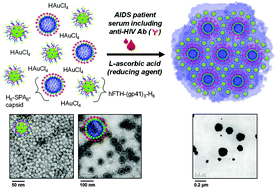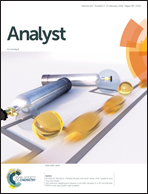Performance of point-of-care diagnosis of AIDS: label-free one-step-immunoassay vs. lateral flow assay†
Abstract
The objective of this study is to develop an accurate, rapid, simple, and label-free assay technology that enables point-of-care diagnosis of AIDS. For this, 3-dimensional (3D) probes to sensitively detect anti-HIV antibodies were designed and synthesized by genetically presenting a HIV antigen (gp41) on the surface of engineered human ferritin nanoparticles. The 3D probes also present multi-copies of the hexa-histidine peptide (H6) on their surface to chemisorb gold ions (Au3+), which is essential for the generation and self-enhancement of assay signals. The developed new assay technology (named “one-step-immunoassay”) quickly produced clear optical signals through a simple and convenient one-step procedure. The diagnostic performance of the one-step-immunoassay was compared with that of the conventional lateral flow assay (LFA) using 30 AIDS patient and 20 healthy sera. The sensitivity of LFA was only 63% when a single antigen (gp41) was used but enhanced to 90% when three different antigens (gp41, p24, and gp120) were used together as the assay probes. In contrast, the one-step-immunoassay using only gp41 produced strong optical signals within 15 min without causing any false negative/positive signals, showing 100% sensitivity and 100% specificity and holding promising potential for clinical point-of-care diagnosis of AIDS.



 Please wait while we load your content...
Please wait while we load your content...